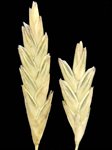
T. longiceps spikelets.
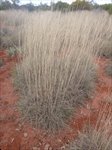
T. longiceps habitat.

T. longiceps sheath and orifice.
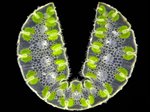
T. longiceps leaf section.
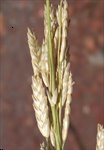
T. longiceps inflorescence.
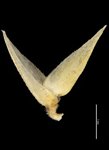
T. longiceps glumes.
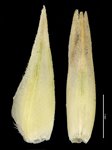
T. longiceps lemmas.
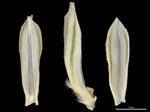
T. longiceps paleas,

T. longiceps map.
Name
Triodia longiceps J.M. Black
Citation
Trans. & Proc. Roy. Soc. South Australia 54: 59 (1930)
Derivation
longiceps — from Latin longus, long, and –ceps, head, in reference to the long, many-flowered spikelets of this species.Common name
Giant Grey Spinifex
Synonyms
None
Diagnostic features
Very robust plants; foliage non-resinous; leaf sheath surfaces glabrous; orifice glabrous or with minute hairs <1 mm long; leaf blades thick, amphistomatous (hard-type), dull blue-green when fresh; inflorescence branched; longest basal pedicels 1–4.5 mm long; lower glume 2.2–4.7 mm long, triangular to elliptic, 1–3-nerved; lemma entire to shortly lobed, not awned, uniformly indurated, usually hairy along midline and margins; lowest lemma midlobe 0–0.4 mm long; usually associated with drainage lines or alluvial flats, widespread.
Habitat
Occurs predominantly along drainage lines and alluvial zones of rivers and creeks, sometimes ascending onto the lower slopes of rocky hills. Extensive populations occur on old alluvial flats in the Fortescue Valley
Distribution and frequency
Widespread throughout arid Australia. Fairly common throughout the whole of the Pilbara bioregion, and in isolated populations throughout Carnarvon, Gascoyne, Little Sandy and Great Sandy Desert bioregions.
Similar species
Triodia longiceps belongs to the Angusta-Wiseana group, by virtue of having amphistomatous (hard-type) leaf blades and 1–3-nerved glumes.
The combination of glabrous or minutely hairy orifices and amphistomatous (hard-type) leaves is shared by only a few other species (most amphistomatous species have either woolly or straight hairs at the orifice).
Some forms of Triodia angusta without orifice hairs can be mistaken for T. longiceps. Triodia angusta can be distinguished by having secund spikelet arrangement and membranous to papery glumes (spikelet arrangement not secund on panicle branchlets, and glumes indurated in T. longiceps).
Triodia basedowii and T. glabra have glumes with ≥6 nerves.
Triodia longiceps X wiseana hybrids can be distinguished from T. longiceps by the presence of hairs more than 1 mm long at the orifice (T. longiceps lacks hairs, or have only minute hairs <1 mm long at the orifice).
Conservation status
Not considered at risk.
Identification without florets
Triodia longiceps can be distinguished from all species except glabrous forms of T. angusta by a combination of amphistomatous (hard-type) leaf blades, glabrous or only minutely hairy leaf sheath and orifice and glumes 1–3-nerved. Triodia angusta can be distinguished by having secund spikelet arrangement and membranous to papery glumes (spikelet arrangement not secund on panicle branchlets, and glumes indurated in T. longiceps).Variation
The glumes are reported as being 3.5–6 mm long in Lazarides (1997), Lazarides et al. (2005) and (Sharp & Simon, 2002; Simon & Alonso, 2014), but in the Pilbara glumes are smaller, 2.2–6 mm long; plants in central Australia also have smaller glumes than previously reported.
Notes
The concept of T. longiceps used here is the same as that of Lazarides (1997), Lazarides et al. (2005) and Ausgrass (Sharp & Simon, 2002; Simon & Alonso, 2014), which contain full descriptions.
Rare hybrids with T. wiseana are known — see Triodia longiceps X wiseana species profile.